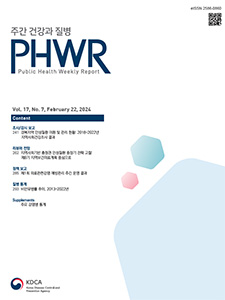Current Issue
Vol.17 No.7, February 22, 2024
-
Surveillance Reports 2024-02-22
 0
0
 363
363
 158
158
Chronic Disease Morbidity and Management Status in Gyeongsangbuk-do: A Summary of the 2018–2022 Community Health Survey
Seul Koo, Moon-Soo Lee
Public Health Weekly Report 2024; 17(7): 241-261 https://doi.org/10.56786/PHWR.2024.17.7.1 Abstract
AbstractFocusing on the Gyeongsangbuk-do statistics from the 2018–2022 Korea Community Health Survey, we identified the latest chronic disease morbidity and management status and disparities among regions (si‧gun) in Gyeongsangbuk-do. In 2022, diagnosed high blood pressure and diabetes rates were 19.1% and 8.9%, respectively; treatment of high blood pressure and diabetes rates were 94.8% and 94.1%, respectively; blood pressure and blood glucose level awareness rates were 66.2% and 28.9%, respectively; and stroke and myocardial infarction early symptom awareness rates were 62.1% and 50.5%, respectively. All of the listed indicators were at levels better than the nationwide values (median values of regions/cities [si‧gun‧gu]). Among them, blood pressure and blood glucose level awareness rates steadily improved over the past 5 years. The recent 5-year trend of regional disparities within Gyeongsangbuk-do showed that while the disparity in diabetes-related indicators increased among regions (si‧gun), the disparity in the treatment rates of those with hypertension and awareness rates of blood pressure level decreased steadily.
-
Review & Perspective 2024-02-22
 0
0
 267
267
 124
124
Review of Chungcheong Region’s Community-based Mid-to-long-term Plans for Chronic Disease: Focusing on the 8th Regional Health Care Plan
Gyeongmin Lee, MinSoo Kim, SeungHoon Kim, MyungBae Park, Young Choi, Eunah Kim, Yoolwon Jeong, JeongMin Yang, Seoncheol Lim, Sunghyun Kang, Soohwan Kim, JaeHyun Kim
Public Health Weekly Report 2024; 17(7): 262-284 https://doi.org/10.56786/PHWR.2024.17.7.2AbstractLong-term strategies are necessary to address the prevention and management of chronic diseases due to the aging population in the Chungcheong region. Upon reviewing the Regional Healthcare Plan by municipality, major chronic diseases were categorized into hypertension, diabetes, cerebrovascular diseases, infectious diseases, mental illnesses, and cancer. It was noted that most of these are interconnected with regional projects. To achieve sustainable operations for public health centers, systematic standardization of regional projects that are feasible for the public health center’s operation, efficient streamlining of overlapping initiatives, and integration of existing programs need to be pursued.
-
Policy Notes 2024-02-22
 0
0
 263
263
 111
111
2023 Healthcare-Associated Infection Prevention & Control Week
Hoon Cho, Yeon-hee Woo, Sook-kyung Park
Public Health Weekly Report 2024; 17(7): 285-292 https://doi.org/10.56786/PHWR.2024.17.7.3
To create a safer culture in terms of avoiding healthcare-associated infections, the Korea Disease Control and Prevention Agency designated every third week of October as a “Healthcare-Associated Infection Prevention & Control Week (HIPCW)”. In commemoration of the first HIPCW in the Republic of Korea in 2023, events such as expert forum and photo contests based on participation in medical will be held. Additionally, active infection control awareness will be raised.
-
QuickStats 2024-02-22
 0
0
 140
140
 319
319
Trends in Prevalence of Obesity, 2013–2022
Public Health Weekly Report 2024; 17(7): 293-294 https://doi.org/10.56786/PHWR.2024.17.7.4

pp. 1~2097
Most Keyword
?
What is Most Keyword?
- It is the most frequently used keyword in articles in this journal for the past two years.
Most Read
-
Waterborne and Foodborne Disease Outbreaks in the Republic of Korea, 2023
Myung-Jae Hwang, So Yeon Park, Hyungjun Kim, Se Jeong Yang, Sungchan Yang, Jin Seon Yang
Public Health Weekly Report 2025;18: 17-32 https://doi.org/10.56786/PHWR.2025.18.1.2 -
Implementation Plan for the Coronavirus Disease 2019 Vaccination for the 2024–2025 Season: Recommendations of the 6th Expert Committee on Immunization Practices
Hyewook Hwang, Wookeon Lee, Seohyeon Ahn, Young-Sook Choi, Seunghyun Lewis Kwon, Dongwoo Lee, Eun Hwa Choi, SokGoo Lee
Public Health Weekly Report 2025;18: 90-102 https://doi.org/10.56786/PHWR.2025.18.2.3
Editorial Office
+82-43-719-7569





 Full Text
Full Text Cite
Cite


